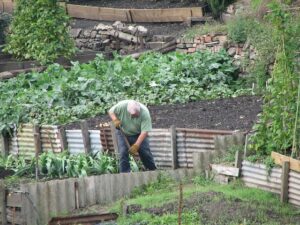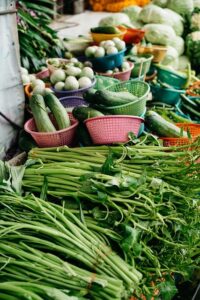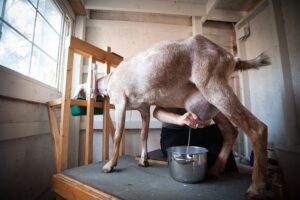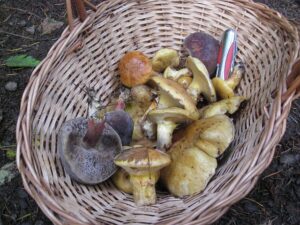Introduction
I started my homesteading journey because I was interested in self-sufficiency and food and energy security. What I’ve learned on my journey is homesteading can mean different things. For some people, it means continuing to live in urban areas but doing what they can to grow more of their food and be more self-sufficient. For others, it means buying land so they can raise all their food and be off-grid. Most people fall somewhere in between This article is about essential homesteading skills. Some of these skills may not apply to your situation. Take what you need and leave the rest.

Gardening and Farming
Basics of Soil and Composting
Understanding soil composition and the art of composting forms the backbone of successful homesteading. Healthy soil is brimming with organic matter and beneficial microorganisms that contribute to plant health. Composting is a sustainable way to enrich your soil by recycling organic waste from your kitchen and garden into nutrient-rich compost.
Planting and Harvesting Techniques

Mastering the skills of planting and harvesting is crucial to maximize yield and minimize waste. This includes knowing the right time to plant different crops, understanding the spacing and depth requirements of various plants, and learning the techniques of harvesting without damaging the plants or the soil.
For more about vegetable gardening check out my artilces here.
Pest and Weed Management
Effective pest and weed management is vital to protect your crops. This involves identifying common pests and weeds in your area, understanding their life cycles, and using appropriate, often organic and sustainable methods to control them.
Crop Rotation and Polyculture
Crop rotation and polyculture are essential strategies for maintaining soil fertility and combating pests and diseases. Crop rotation involves changing the types of crops grown in a specific area over different seasons or years, whereas polyculture involves growing multiple crops in the same space, mimicking the diversity of natural ecosystems. This article belongs to pineyriverhomestead.com, published 10-22-23
Livestock Management
Choosing the Right Livestock

Selecting the right livestock for your homestead depends on numerous factors such as available resources, climate, market demand, and your personal interests. Common choices include poultry for eggs and meat, dairy cattle for milk, and sheep for wool.
Basic Animal Care and Health
The well-being of your livestock is fundamental to a successful homestead. This requires knowledge of basic animal care, including feeding, housing, and routine health checks. Regular vaccinations, deworming, and prompt medical attention at signs of illness are critical elements of livestock health management.
Breeding and Raising Young
Breeding livestock is a significant aspect of homesteading, ensuring the continuity of your herd or flock. This involves understanding animal mating behaviors, gestation periods, and the care required for newborn animals. Raising young livestock often requires additional attention, including special feeding and protection from predators.
Butchering and Processing
Butchering and processing livestock is often a part of homesteading, particularly for meat production. This involves knowledge of humane slaughtering practices, proper meat handling and storage, and skills in basic meat processing techniques such as curing and smoking. It’s important to note that local regulations may govern the slaughter and sale of livestock products, so be sure to familiarize yourself with the relevant laws.
Food Preservation
Canning and Bottling
Canning and bottling are effective means of preserving food, extending their shelf life, and locking in the flavors. These methods involve the process of heat sterilization to kill or deactivate enzymes and bacteria that cause food spoilage.
Dehydrating
Dehydrating serves as a cost-effective and practical method for preserving different types of food, particularly fruits and vegetables. This method works by removing water content from food to inhibit the growth of spoilage-causing microorganisms.
Fermenting
Fermenting is a traditional food preservation technique that not only extends the shelf life of food but also enhances its nutritional value and taste. It involves the conversion of carbohydrates to alcohol or organic acids using microorganisms under anaerobic conditions.
For more on fermenting check out my article “What is Fermentation?”
Freezing and Cold Storage
Freezing and cold storage are perhaps the most common preservation techniques used in modern households. These methods slow down the decomposition process by halting the growth of microorganisms that cause food spoilage. It’s important to note that proper packaging is critical in freezing and storing food to maintain its quality.
Pickling
Pickling has been used for centuries as a method of preserving food, particularly vegetables. This technique involves submerging food in an acidic solution, usually vinegar or brine, to create an environment that inhibits the growth of bacteria and other microorganisms.
For more about pickling check out my article on pickling here.
Basic Carpentry
Building and Repairing Structures
Building and repairing structures is a skill that requires a deep understanding of various materials, techniques, and tools. It involves structural design principles and the ability to diagnose and fix issues that may compromise the structural integrity of a building. Whether it’s an office building, a residential house, or a simple garden shed, each structure requires the right method and tools for building and repairing.
Understanding Tools and Their Uses
Tools are the backbone of construction and repair work. Each tool has a specific use, and understanding these uses can greatly improve the efficiency and effectiveness of any building or repair project. For instance, hammers are primarily used for driving nails, while screwdrivers are used for inserting and tightening screws. Similarly, power drills make holes in different types of materials, and wrenches are used for tightening bolts and nuts. Understanding the correct use of each tool is not only important for the successful completion of a task but also essential for the safety of the user.
Water and Energy Management
Rainwater Harvesting and Storage
Rainwater harvesting is an age-old practice of collecting and storing rainwater for later use. This eco-friendly method can significantly reduce reliance on municipal water sources, thus conserving water. Typically, rainwater is collected from surfaces on which rain falls, such as rooftops, and then channeled to a rainwater storage tank. The stored water can then be used for various purposes like gardening, irrigation, and even as drinking water, after appropriate treatment.
Solar and Wind Energy Basics
Solar and wind energy are two key renewable energy sources that harness the natural elements to generate power. Solar energy captures the sun’s rays using photovoltaic cells, converting sunlight directly into electricity. On the other hand, wind energy utilizes the power of moving air, harnessed through wind turbines, to generate electrical power. Both solar and wind energy have the potential to significantly decrease our dependency on fossil fuels, thereby reducing greenhouse gas emissions and contributing towards a sustainable future.
Self-Sufficiency Skills
Foraging

Foraging involves searching for and gathering wild food resources. It is a skill that has been practiced by our ancestors and is still relevant today. Foraging not only provides an opportunity to connect with nature but also serves as a sustainable source of food. From wild berries and edible plants to medicinal herbs, foraging can be a rewarding practice. However, it’s important to have a clear understanding of what is safe to consume and what is not.
Hunting and Fishing
Hunting and fishing are traditional skills for acquiring meat. Armed with knowledge of the local wildlife, hunting techniques, and fishing methods, one can harvest a variety of game and fish species. These skills not only provide a source of nutritious food but also imbue a deep respect for nature and the cycle of life.
Making Clothes and Tools
The ability to craft clothes and tools is a fundamental aspect of self-sufficiency. From sewing and repairing clothes to crafting basic tools and utensils, these skills can prove invaluable in a survival situation. Learning to use natural or recycled materials effectively can also contribute to sustainable living.
Emergency Preparedness and First Aid
Preparing for emergencies and having a basic understanding of first aid is a crucial aspect of self-sufficiency. This involves having a well-stocked emergency kit, knowing how to react in different emergency scenarios, and having the ability to administer basic first aid. These skills can make a significant difference in the event of a crisis or an accident.
Conclusion
These are the essential homesteading skills one needs to be self-sufficient and to live responsibly and sustainably. While it may seem like a daunting task to acquire all of these skills, it’s important to remember that homesteading is a journey and not a destination. It takes time, patience, and perseverance to learn these skills, but the rewards are well worth it. So whether you live in a rural area or an urban setting, there are many ways to incorporate homesteading principles into your lifestyle and become more self-sufficient. Start small, keep learning, and enjoy the journey towards a more sustainable way of living. So let’s continue to learn, adapt, and embrace the skills necessary for homesteading and self-sufficiency.
Additional Resources
- “The Encyclopedia of Country Living” by Carla Emery
- “The Homesteading Handbook” by Abigail R. Gehring
- “The Backyard Homestead” by Carleen Madigan

